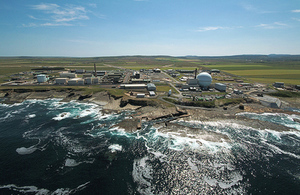Dounreay supercompactor prepares for re-start
Dounreay’s low level waste drum crushing plant will soon be back in full working order.

The new supercompactor for the Waste Receipt, Assay, Characterisation and Supercompaction plant (WRACS) has arrived on site and is now being installed.
Two cranes hauled the 45 tonne drum-crusher into the air and delivered it into the building through the roof hatch, with operators and contractors inside waiting to guide it to its final position.
The original drum-crusher suffered a major mechanical failure in August 2011. When it became apparent that it could not be fixed, DSRL found a brand new supercompactor that was surplus to requirements, saving both time and money.
There have been a lot of positives with this story, says DSRL project manager Graham Beaven.
“We used the containment that housed the old supercompactor to demonstrate the principle of bulk low level waste disposal for the first time,” he explains.
“That unit is now awaiting disposal in the new low level waste vaults.”
The project was recognised in Dounreay’s internal Decommissioning Excellence awards for its contribution to the new disposal strategy, as DSRL worked with the Scottish Environmental Protection Agency to ensure that a satisfactory case could be made that the bulk waste disposal met the best practicable means test.
The WRACS team has been working to assay and characterise the LLW drums while the supercompactor has been out of action, and will have a backlog of approximately 11,000 drums to crush into pucks by the time supercompaction resumes.
The supercompactor is expected to be in operation by April next year, and the team will work shifts until the backlog is cleared. 10/12/2013
Dounreay’s low level waste drum crushing plant will soon be back in full working order.
The new supercompactor for the Waste Receipt, Assay, Characterisation and Supercompaction plant (WRACS) has arrived on site and is now being installed.
Two cranes hauled the 45 tonne drum-crusher into the air and delivered it into the building through the roof hatch, with operators and contractors inside waiting to guide it to its final position.
The original drum-crusher suffered a major mechanical failure in August 2011. When it became apparent that it could not be fixed, DSRL found a brand new supercompactor that was surplus to requirements, saving both time and money.
There have been a lot of positives with this story, says DSRL project manager Graham Beaven.
“We used the containment that housed the old supercompactor to demonstrate the principle of bulk low level waste disposal for the first time,” he explains.
“That unit is now awaiting disposal in the new low level waste vaults.”
The project was recognised in Dounreay’s internal Decommissioning Excellence awards for its contribution to the new disposal strategy, as DSRL worked with the Scottish Environmental Protection Agency to ensure that a satisfactory case could be made that the bulk waste disposal met the best practicable means test.
The WRACS team has been working to assay and characterise the LLW drums while the supercompactor has been out of action, and will have a backlog of approximately 11,000 drums to crush into pucks by the time supercompaction resumes.
The supercompactor is expected to be in operation by April next year, and the team will work shifts until the backlog is cleared.